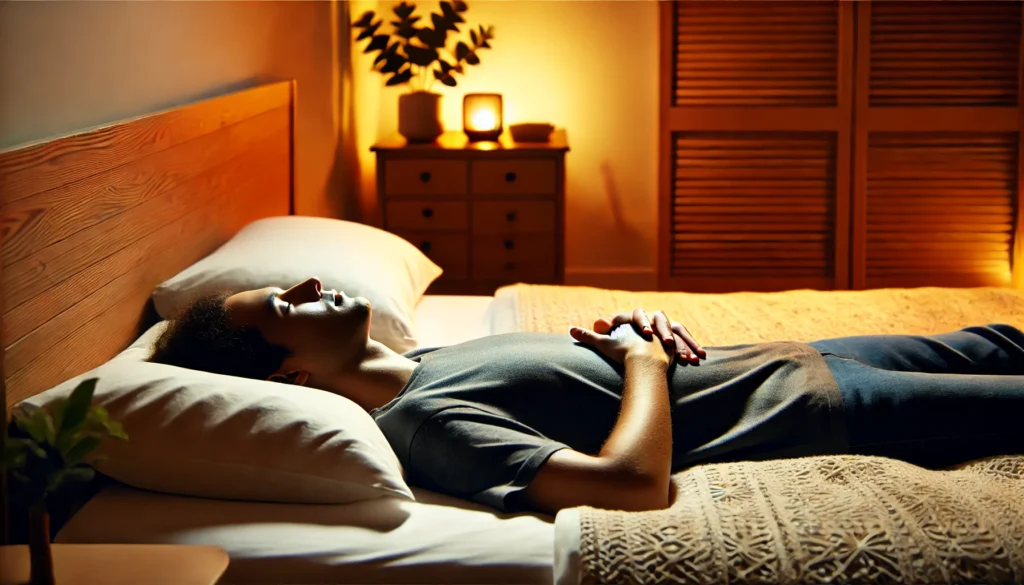Before we explore specific breathing techniques, it’s crucial to understand what panic attacks are. These episodes are sudden surges of overwhelming fear and anxiety, often accompanied by physical symptoms such as a racing heartbeat, shortness of breath, dizziness, and a sense of impending doom. While panic attacks are not life-threatening, they can significantly affect your quality of life.
You may also like: Effective Stress Management Techniques for Daily Life
Recognizing the Symptoms
Panic attacks manifest in various ways, and understanding these symptoms can help in early identification. Physical symptoms often include sweating, trembling, and feelings of choking. Emotional responses might include a fear of losing control or going crazy. Recognizing these signs early can be crucial in managing the episode effectively.
Triggers and Causes
While the exact causes of panic attacks are not fully understood, certain factors can increase their likelihood. Stressful life events, genetic predisposition, and certain medical conditions can be significant contributors. Identifying personal triggers, such as specific environments or situations, can help in anticipating and mitigating future attacks.
Psychological Impact
The psychological impact of panic attacks can be profound, often leading to a cycle of fear and avoidance. Sufferers may develop phobias related to places or situations where previous attacks occurred. This can lead to a reduced quality of life, as individuals might avoid social interactions or public places.
The Science Behind Breathing and Anxiety
The connection between breathing and anxiety is rooted in the body’s physiological response to stress. When you experience stress, your sympathetic nervous system triggers the “fight or flight” response, increasing your heart rate and breathing to prepare your body for action. However, controlled breathing can activate the parasympathetic nervous system, which promotes relaxation and a sense of calm.
Fight or Flight Response
The fight or flight response is an automatic physiological reaction to perceived threats. It prepares the body to either confront or flee from danger. Breathing becomes rapid and shallow, supplying muscles with oxygen for quick action. Understanding this response helps in appreciating the role of controlled breathing in reversing its effects.
Parasympathetic Activation
Controlled breathing techniques can stimulate the parasympathetic nervous system, which is responsible for the body’s rest and digest functions. This activation counteracts the adrenaline surge from the fight or flight response, slowing the heart rate and promoting relaxation. It highlights the power of breathing in managing stress and anxiety.
The Role of Oxygen
Oxygen plays a critical role in our body’s stress response. During panic attacks, rapid breathing can lead to hyperventilation, reducing carbon dioxide levels and causing dizziness or tingling sensations. Controlled breathing helps balance oxygen and carbon dioxide levels, alleviating these symptoms and restoring calm.
Effective Breathing Techniques
Diaphragmatic Breathing
Also known as “abdominal breathing,” diaphragmatic breathing involves using the diaphragm efficiently to increase oxygen intake and promote relaxation.
Steps to Master Diaphragmatic Breathing
- Find a Comfortable Position: Sit or lie down in a comfortable position, ensuring your back is supported.
- Place Your Hands: Place one hand on your chest and the other on your abdomen, helping you focus on the movement of your diaphragm.
- Inhale Deeply: Breathe in slowly through your nose, allowing your abdomen to rise while keeping your chest still. Visualize the air filling your lungs completely.
- Exhale Slowly: Exhale gently through your mouth, noticing your abdomen fall. Imagine releasing tension with each exhale.
- Repeat: Continue this cycle for several minutes, focusing on the rise and fall of your abdomen, creating a rhythmic pattern that promotes calmness.
Benefits of Diaphragmatic Breathing
Practicing this technique enhances lung efficiency and strengthens the diaphragm. It helps in reducing stress by lowering cortisol levels and encourages mindfulness by focusing on the breath. Regular practice can improve overall respiratory health and resilience to stress.
Common Mistakes and How to Avoid Them
A common mistake is using the chest instead of the diaphragm, which can limit the effectiveness of the technique. Ensure your abdomen, not your chest, rises with each breath. Another mistake is breathing too quickly; slow, deliberate breaths are essential for maximizing relaxation.
4-7-8 Breathing Technique
This method, developed by Dr. Andrew Weil, is a powerful technique to calm your nervous system.
How to Perform the 4-7-8 Breathing Technique
- Get Comfortable: Sit or lie down comfortably, ensuring your spine is straight.
- Inhale: Breathe in quietly through your nose for a count of 4, feeling the air fill your lungs.
- Hold: Hold your breath for a count of 7, allowing the oxygen to circulate throughout your body.
- Exhale: Exhale completely through your mouth for a count of 8, making a whooshing sound as you release the air.
- Repeat: Repeat the cycle at least four times, gradually increasing as you become more comfortable with the rhythm.

Psychological Benefits
The 4-7-8 technique can be a quick fix for moments of acute stress. It helps in reducing anxiety levels and can improve sleep quality when practiced before bedtime. The extended exhalation promotes a sense of release and tranquility, beneficial for calming a racing mind.
Integrating 4-7-8 in Daily Routine
Incorporate this technique into your daily routine by practicing it twice a day. Use it during breaks at work or before stressful meetings to center yourself. With regular practice, this technique can become a go-to tool for managing stress throughout the day.
Box Breathing
Box breathing, also known as square breathing, is a simple and effective way to manage stress and anxiety.
Step-by-Step Guide to Box Breathing
- Visualize a Box: Imagine drawing a box as you breathe, using each side to guide your breath.
- Inhale: Inhale slowly for a count of 4 as you draw the first side, filling your lungs with air.
- Hold: Hold your breath for a count of 4 as you draw the second side, maintaining the air within.
- Exhale: Exhale slowly for a count of 4 as you draw the third side, releasing the air gently.
- Hold: Hold your breath for another count of 4 as you complete the box, preparing for the next inhale.
- Repeat: Continue for several minutes, maintaining the rhythmic pattern.
Enhancing Focus with Box Breathing
Box breathing is a favorite among military personnel and athletes for enhancing focus and performance under pressure. It helps synchronize the mind and body, improving concentration and clarity. Practicing this technique can enhance mental acuity and decision-making in high-stress situations.
Incorporating Visualization
To deepen the practice, incorporate visualization by imagining a peaceful scene or a calming color as you draw each side of the box. This addition can enhance the calming effect and help distract from anxious thoughts, making the practice more effective.
Resonant Breathing
Resonant breathing, or coherent breathing, involves breathing at a rate of about five breaths per minute to enhance heart rate variability and relaxation.
Steps to Practice Resonant Breathing
- Get Comfortable: Sit or lie down in a relaxed position, ensuring your body is at ease.
- Breathe In and Out: Breathe in for a count of 5, filling your lungs with air, and then out for a count of 5, releasing the air slowly.
- Continue: Maintain this rhythm, focusing on the evenness of your breath, ensuring each inhale and exhale is smooth and continuous.
Physiological Benefits
Resonant breathing can enhance heart rate variability, a marker of cardiovascular health and stress resilience. It promotes a balanced autonomic nervous system, reducing stress and improving emotional regulation. This technique can be particularly beneficial for those with high blood pressure or chronic stress.
Creating a Resonant Breathing Environment
Create a conducive environment for practice by choosing a quiet space with minimal distractions. Dim the lights or use calming music to enhance relaxation. Consistent practice in a serene setting can amplify the benefits, making resonant breathing a powerful tool for stress management.
Alternate Nostril Breathing
This yogic practice, known as Nadi Shodhana, helps balance the mind and body.
Detailed Steps for Alternate Nostril Breathing
- Find a Comfortable Seat: Sit cross-legged, ensuring your spine is straight for optimal breathing.
- Close Your Right Nostril: Use your thumb to close your right nostril gently.
- Inhale Through Left Nostril: Breathe in through your left nostril, filling your lungs completely.
- Switch Sides: Close your left nostril with your ring finger and release your right nostril.
- Exhale Through Right Nostril: Breathe out through your right nostril, emptying your lungs.
- Inhale Through Right Nostril: Breathe in through your right nostril, repeating the process.
- Switch and Exhale: Close your right nostril and release your left, exhaling through the left nostril.
- Continue: Repeat for several cycles, focusing on the balance and flow of breath.
Balancing the Mind and Body
Alternate nostril breathing can harmonize the left and right hemispheres of the brain, promoting mental clarity and emotional balance. It is particularly effective in reducing stress and improving concentration. This technique can be a valuable part of a daily mindfulness or yoga practice.
Incorporating into a Yoga Routine
Incorporate alternate nostril breathing into your yoga routine to enhance its calming effects. Practice it at the beginning or end of a yoga session to prepare the mind or conclude with a sense of balance. Consistent practice can deepen your connection to breath and body awareness.

Integrating Breathing Techniques into Daily Life
Regular Practice
To maximize the benefits of these breathing techniques, incorporate them into your daily routine. Regular practice can improve your response to stress and reduce the frequency of panic attacks.
Establishing a Routine
Establish a regular practice routine by setting aside specific times each day for breathing exercises. Morning sessions can set a calm tone for the day, while evening practices can aid in relaxation before sleep. Consistency is key to reaping long-term benefits.
Tracking Progress
Keep a journal to track your progress and note any changes in your stress levels or panic attack frequency. Documenting your experiences can help identify which techniques work best for you and encourage continued practice. Reflecting on improvements can motivate you to maintain your routine.
Adapting to Your Lifestyle
Adapt these techniques to fit your lifestyle by integrating them into daily activities. Practice diaphragmatic breathing during your commute or 4-7-8 breathing before important meetings. Flexibility in practice can ensure you continue to benefit despite a busy schedule.
Combining with Other Strategies
While breathing techniques are effective, consider combining them with other strategies such as mindfulness meditation, progressive muscle relaxation, and cognitive-behavioral therapy for comprehensive anxiety management.
Mindfulness Meditation
Combine breathing techniques with mindfulness meditation to enhance awareness and reduce stress. Focus on your breath as a meditation anchor, allowing thoughts to pass without judgment. This practice can deepen relaxation and improve emotional regulation.
Progressive Muscle Relaxation
Use progressive muscle relaxation alongside breathing exercises to release physical tension. Gradually tense and relax muscle groups while focusing on your breath. This combination can amplify relaxation and reduce anxiety symptoms more effectively.
Cognitive-Behavioral Therapy
Incorporate breathing techniques into cognitive-behavioral therapy (CBT) sessions to enhance their effectiveness. Use breathing exercises to calm the mind before addressing anxious thoughts. This integration can improve the outcomes of CBT by providing immediate relief from anxiety symptoms.
Seeking Professional Help
If panic attacks persist despite self-help strategies, it may be beneficial to seek guidance from a healthcare professional. They can offer additional tools and support tailored to your needs.
When to Seek Help
Recognize when self-help strategies are insufficient and seek professional assistance. Persistent or worsening panic attacks, interference with daily activities, or severe distress are signs to consult a healthcare provider. Early intervention can prevent escalation and improve outcomes.
Types of Professional Support
Explore various professional support options, including therapy, medication, and support groups. Cognitive-behavioral therapy and medication can effectively reduce panic attack frequency. Support groups provide a community for sharing experiences and coping strategies.
Collaborating with Professionals
Collaborate with healthcare professionals to create a personalized anxiety management plan. Share your experiences with breathing techniques to tailor the approach to your needs. Professional guidance can enhance the effectiveness of your self-help strategies.
The Future of Breathing Techniques in Mental Health
As research continues to explore the mind-body connection, breathing techniques are gaining recognition as valuable tools in mental health management. Emerging technologies, such as biofeedback and virtual reality, are being integrated with traditional breathing exercises to enhance their effectiveness and accessibility.
Advances in Research
Ongoing research is uncovering new insights into the physiological and psychological benefits of breathing techniques. Studies are exploring their impact on brain function, stress reduction, and emotional regulation. This growing body of evidence is solidifying their role in mental health care.
Integration with Technology
Emerging technologies are enhancing the accessibility and effectiveness of breathing techniques. Biofeedback devices provide real-time data on breathing patterns, helping users optimize their practice. Virtual reality applications offer immersive environments for guided breathing exercises, making them more engaging and effective.
Potential for Broader Applications
The potential applications of breathing techniques extend beyond anxiety and panic attack management. They are being explored for use in pain management, athletic performance, and workplace stress reduction. As awareness grows, these techniques could become integral to various aspects of health and wellness.
Conclusion
Breathing techniques offer a practical and immediate way to manage panic attacks and anxiety. By understanding and practicing these methods, you can regain control over your body’s response to stress, promoting a sense of calm and well-being. Whether you’re a health and wellness coach, a science journalist, or a biohacker, these techniques provide valuable insights into optimizing mental health and resilience.
Embracing a Holistic Approach
Embrace a holistic approach to mental health by incorporating breathing techniques into your overall wellness strategy. Combine them with other practices like exercise, nutrition, and mindfulness for a comprehensive approach to stress management. A balanced lifestyle can enhance the effectiveness of these techniques and improve overall well-being.
Sharing Knowledge and Experiences
Share your knowledge and experiences with breathing techniques to help others manage anxiety and panic attacks. Educate friends, family, or colleagues about the benefits and methods of practice. Creating a supportive community can empower more individuals to utilize these valuable tools.

Continuing the Journey
Continue your journey with breathing techniques by exploring new methods and staying informed about advancements in research and technology. Stay open to adapting your practice as new insights emerge, ensuring you continue to benefit from these powerful tools. Commitment to ongoing learning can enhance your resilience and mental health.
Further Reading:
Can regular physical exercise be a treatment for panic disorder? A systematic review
How can you stop a panic attack?
Panic Attacks, Exercise, and Anxiety
Important Note: The information contained in this article is for general informational purposes only, and should not be construed as health or medical advice, nor is it intended to diagnose, prevent, treat, or cure any disease or health condition. Before embarking on any diet, fitness regimen, or program of nutritional supplementation, it is advisable to consult your healthcare professional in order to determine its safety and probable efficacy in terms of your individual state of health.
Regarding Nutritional Supplements Or Other Non-Prescription Health Products: If any nutritional supplements or other non-prescription health products are mentioned in the foregoing article, any claims or statements made about them have not been evaluated by the U.S. Food and Drug Administration, and such nutritional supplements or other health products are not intended to diagnose, treat, cure, or prevent any disease.


